Ever found yourself in a fix with damaged wood? Wondering if you can really screw into wood filler? Let’s dive into the details and find out!
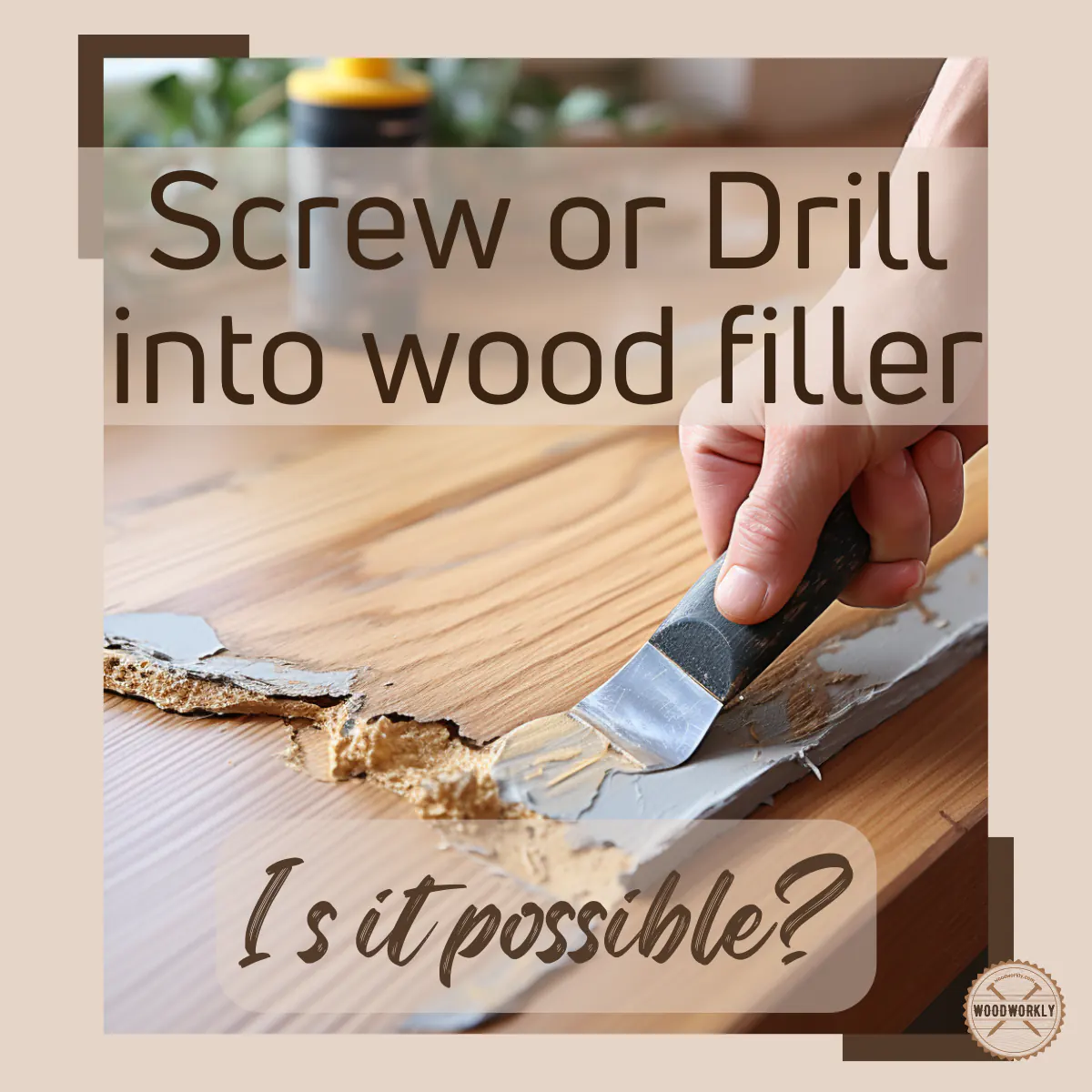
Wood filler is mostly used for repairing chips, scratches, gouges, and other surface imperfections of your loved furniture and woodwork to make them fresh and new again.
Wood filler is able to fill holes and cracks on wood surfaces. It hardens on the surface while preserving the integrity of the wood.
There may be occasions when it’s necessary to insert nails or screws into an area after filling a hole or crack using wood filler.
I was curious about this and asked for expert advice when I was a beginner.
Now, with years of experience under my belt, allow me to explain: Can you screw into wood filler?
Yes, you can screw into wood filler, especially with two-part epoxy resin since it is durable and capable of handling the stress of a screw. Drill a pilot hole first, avoid over-tightening the screw, and allow the filler to fully cure before screwing.
But there’s more to know.

In this article, I’ll explore whether can you screw into wood filler and can wood filler hold a screw.
Plus I’ll discuss how to screw into wood filler, and best screwable wood filler types.
Furthermore, I’ll answer some frequently asked questions as well.
Let’s jump in!
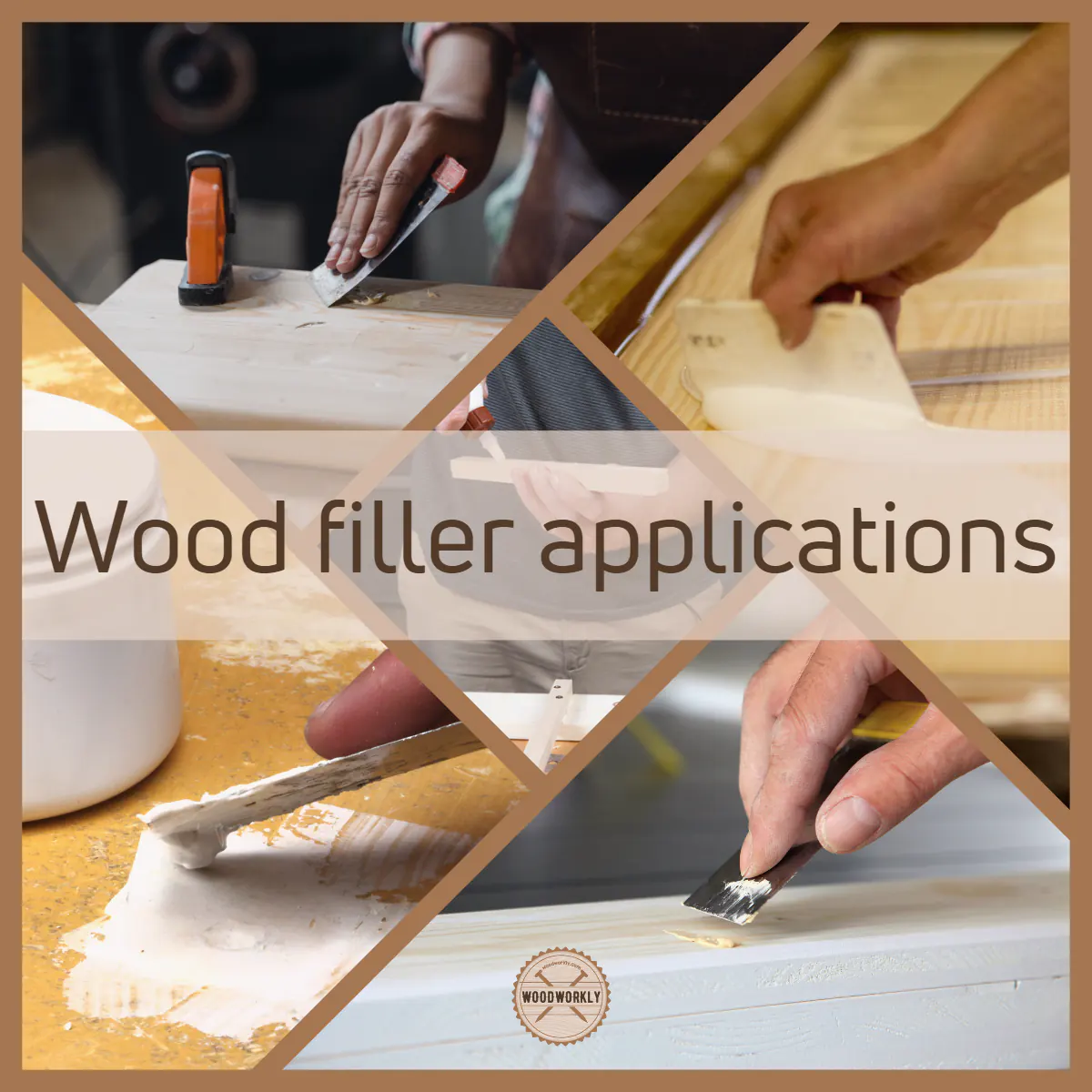
This post contains affiliate links. As an Amazon Associate, I earn from qualifying purchases. I endorse only products I truly recommend. If you make a purchase using one of these links, I may receive compensation at no extra cost to you. For more information, see my disclosure policies.
Can Wood Filler Hold a Screw?
Yes, wood filler can hold a screw. Once the wood filler is cured well you can screw it with a small pilot hole.
Wood filler cannot hold load or stress. It can only hold small screws that carry a very small amount of load or stress.
Heavy load or stress changes the dimensional strength of wood filler and destroys the wood filler.
Therefore, the wood filler does not support well to hold large screws that carry stress and load.
When the wood filler is completely dried and cured you can drill a screw or nail into the preferred area without any issue because of the great flexibility of wood filler.
Tip: If the hole was stripped out of a screw or it is in a hinge mortise, it’s not a good thing to fill the hole using wood filler.
because it’s like filling the wood using particleboard which is incompatible with wood and unable to hold a screw so well.
If you want to fill up stripped-out screw holes or the screw hole in hinge mortise, better to stick with bamboo skewers, toothpicks, or wooden match sticks.
Dip them in wood glue and jam until they fit in the hole. Set them deep into the wood by leaving the ending surface of the mortise and trimming off flush with the surface once the glue is completely set up.
After that, the surface is ready to hold any kind of large or small screw. Predrilling is recommended for good screwing and to prevent the wood from splitting.
Apart from that, it is totally fine to use wood filler to fill up small holes and cracks which doesn’t apply any load or stress.
Most of the wood fillers hold screws so well.
Among different types of wood fillers, Epoxy wood fillers outstand from others in terms of their screw-holding ability.
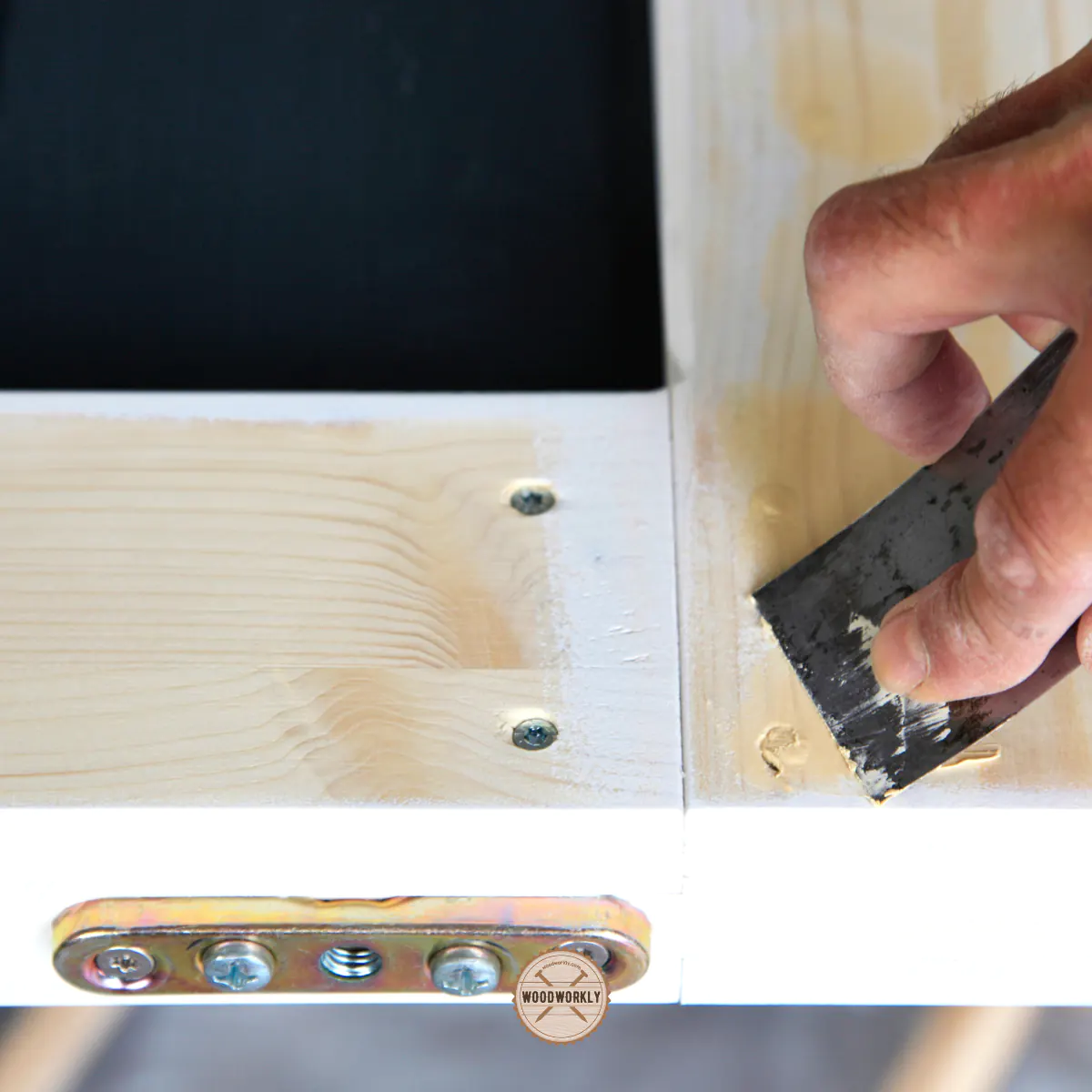
Can You Drill into Wood Filler?
Yes, you can drill into wood filler once it’s fully dried and cured. Two-part epoxy wood filler and multipurpose wood fillers prevent occurring cracks during the drilling process.
When you’re drilling the wood filler to hold screw make sure to consider the depth of the hole. Because sometimes when you drill too deep, that’ll ruin the project.
So, before drilling the wood filler to hold the screw make sure to have a good idea about how deep should you drill to hold the screw tightly.
Follow the below table to get an idea about the perfect depth you should screw into wood filler to prevent cracking.
| Drilling Depth of Wood Filler | Wood Type |
| ¼’’ | Large pieces of firm hardwoods like Oak |
| ½’’ | Medium-firm woods like Fir |
| 5/8’’ | Medium-firm woods like Cherry |
| 1’’ | Softwoods like Cedar |
Types of Wood Filler You Can Screw Into
There’re many available options of wood fillers in shops, but you have to find out which type of wood fillers are best that can screw into without ruining the project.
| Types of Wood Filler | Can You Screw Into? |
| Two-part epoxy wood filler | Yes |
| Simple wood filler | No |
| Multipurpose wood filler | Yes |
| Exterior wood filler | Yes |
As you can see two-part epoxy wood filler, multi-purpose wood filler, and exterior wood fillers are the best options you can screw into.
Among those options, I personally recommend a two-part epoxy wood filler because of its high dimensional strength and flexibility to hold the screw so well.
Now let’s discuss about commercially available screwable wood fillers you can use for this project.
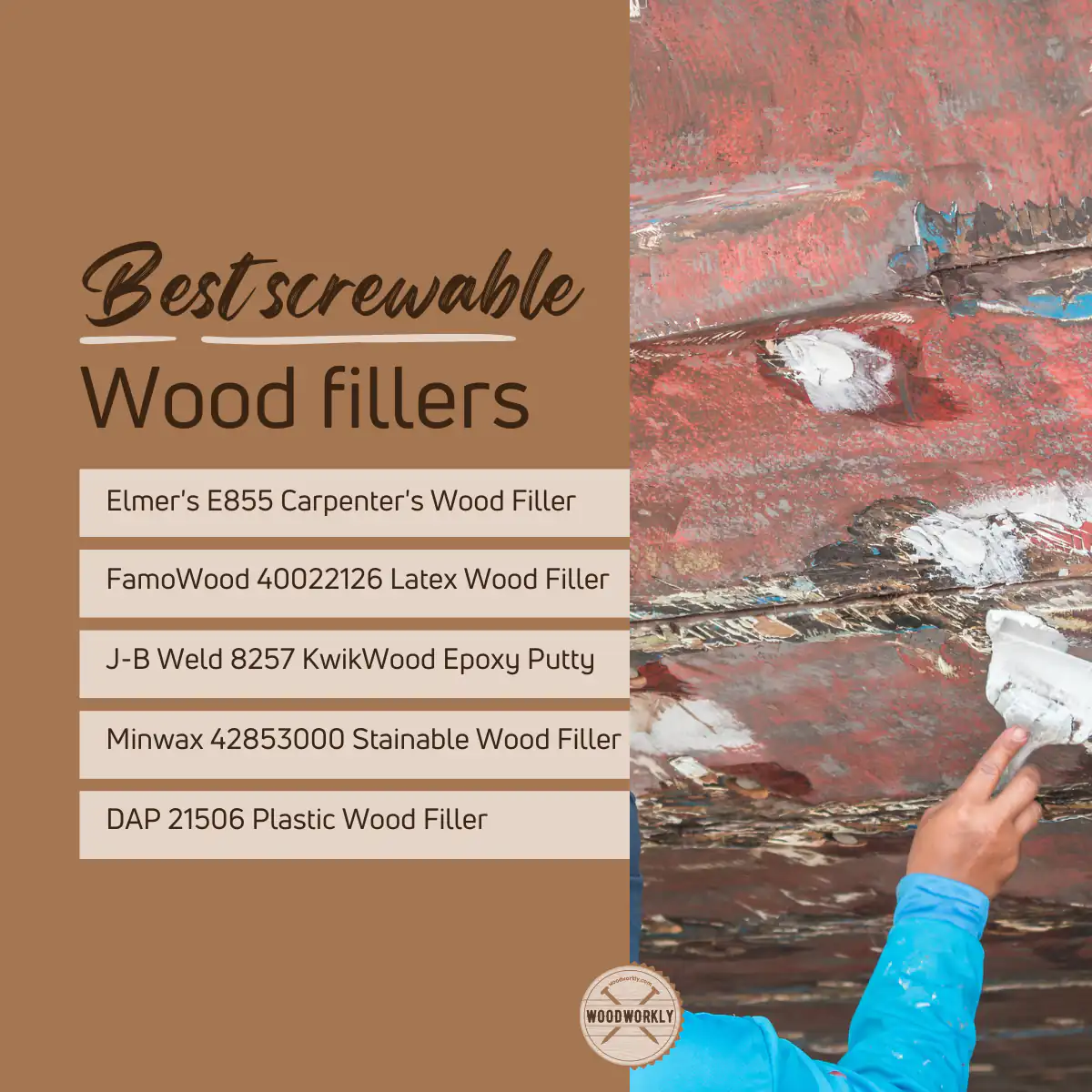
Types of Screwable Wood Fillers
The world of woodworking offers various solutions for fixing imperfections, and wood fillers are a common choice due to their easy use and good results.
When it comes to screwable wood fillers, the key is to choose a type that offers enough durability and strength to hold a screw, especially if it’s not going to bear any significant weight or stress.
Below, I will explore some types of screwable wood fillers that may be beneficial for your woodworking projects.
Epoxy Wood Fillers
The best type of wood filler that can hold a screw is an epoxy-based wood filler.
Epoxy wood fillers are composed of two parts: a hardener and a resin. When mixed together, these two components create a substance that is durable, moldable, and resistant to moisture.
One of the best things about epoxy wood fillers is their strong adhesive qualities.
Epoxy fillers can form a powerful bond with the wood, providing a strong, solid base for screws.
An example of an epoxy wood filler that’s known for its durability is the PC Products PC-Woody Two-Part Wood Repair Epoxy Paste.
This filler sets rock-hard and can be drilled, making it suitable for light screwing tasks.
Multipurpose Wood Fillers
Multipurpose wood fillers, as their name implies, can be used for a variety of applications, including filling in screw holes.
These types of fillers are easy to use and generally dry quickly, allowing you to carry on with your woodworking project without too much delay.
A good multipurpose wood filler to consider is FamoWood 40022126 Latex Wood Filler.
Not only does it dry hard, but it is also sandable, paintable, and stainable, making it versatile for any project.
Remember, for screwing into this filler, it’s important to drill a small pilot hole first to avoid cracking.
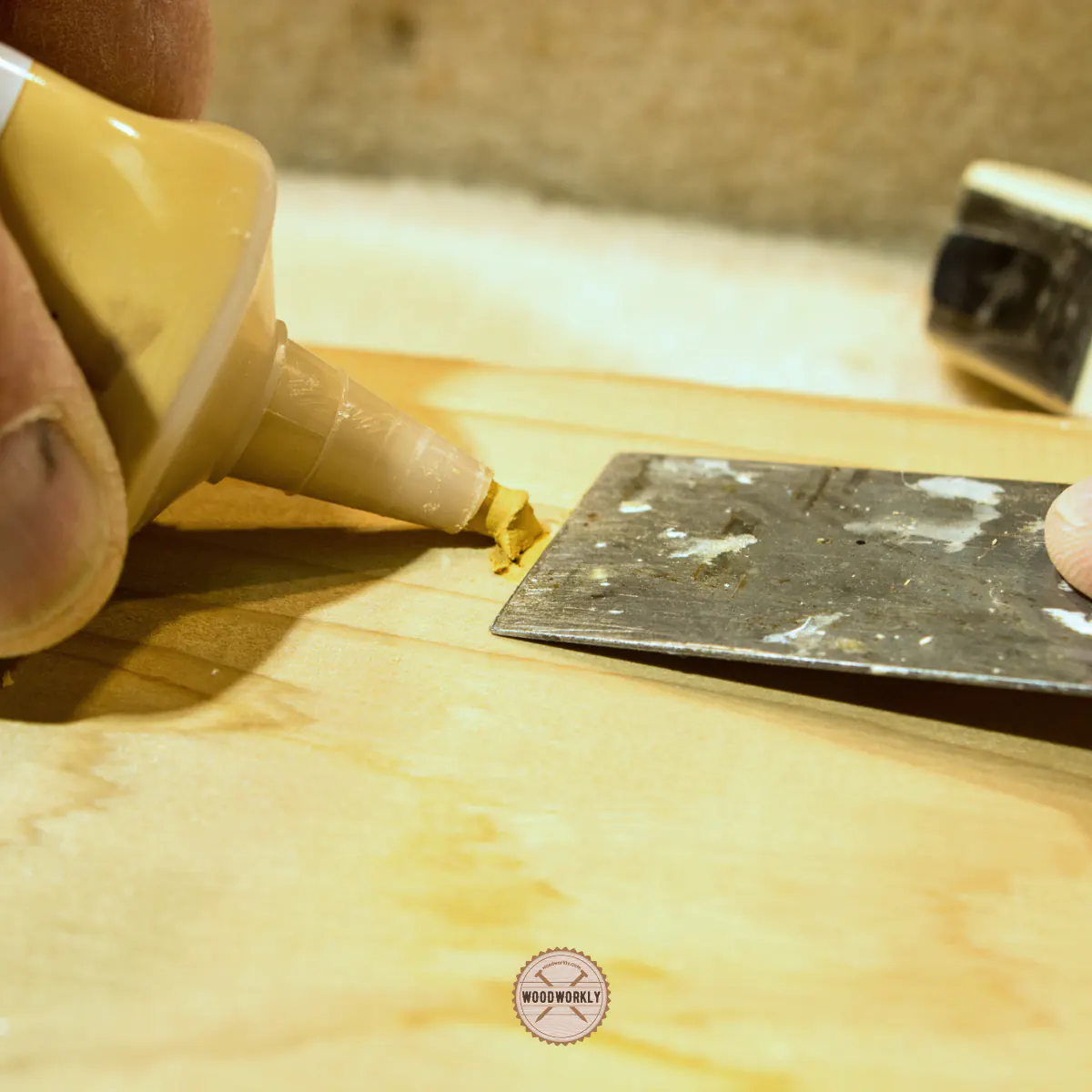
Two-Part Wood Fillers
Two-part wood fillers are similar to epoxy fillers as they consist of a filler and a hardener.
When combined, they form a tough, durable substance that can hold a small screw.
Two-part fillers like Minwax High-Performance Wood Filler are known for their strength and reliability.
This filler is great for filling large holes and can be sanded, painted, and stained once dry.
Remember, while these wood fillers can hold screws, they aren’t designed to bear heavy weight or stress.
For critical structural joints or fixtures, consider other solutions like using dowels or larger pieces of wood.
Follow this guide to know the best method to cut wooden dowels.
Personal Experience and Anecdotes
In my woodworking journey, I’ve found that the type of wood filler you choose will depend on the nature of your project.
For light-duty tasks, where the screw isn’t bearing much weight, epoxy and two-part fillers have been great.
However, for heavier-duty tasks, I often resort to other methods such as using wooden dowels or plugs.
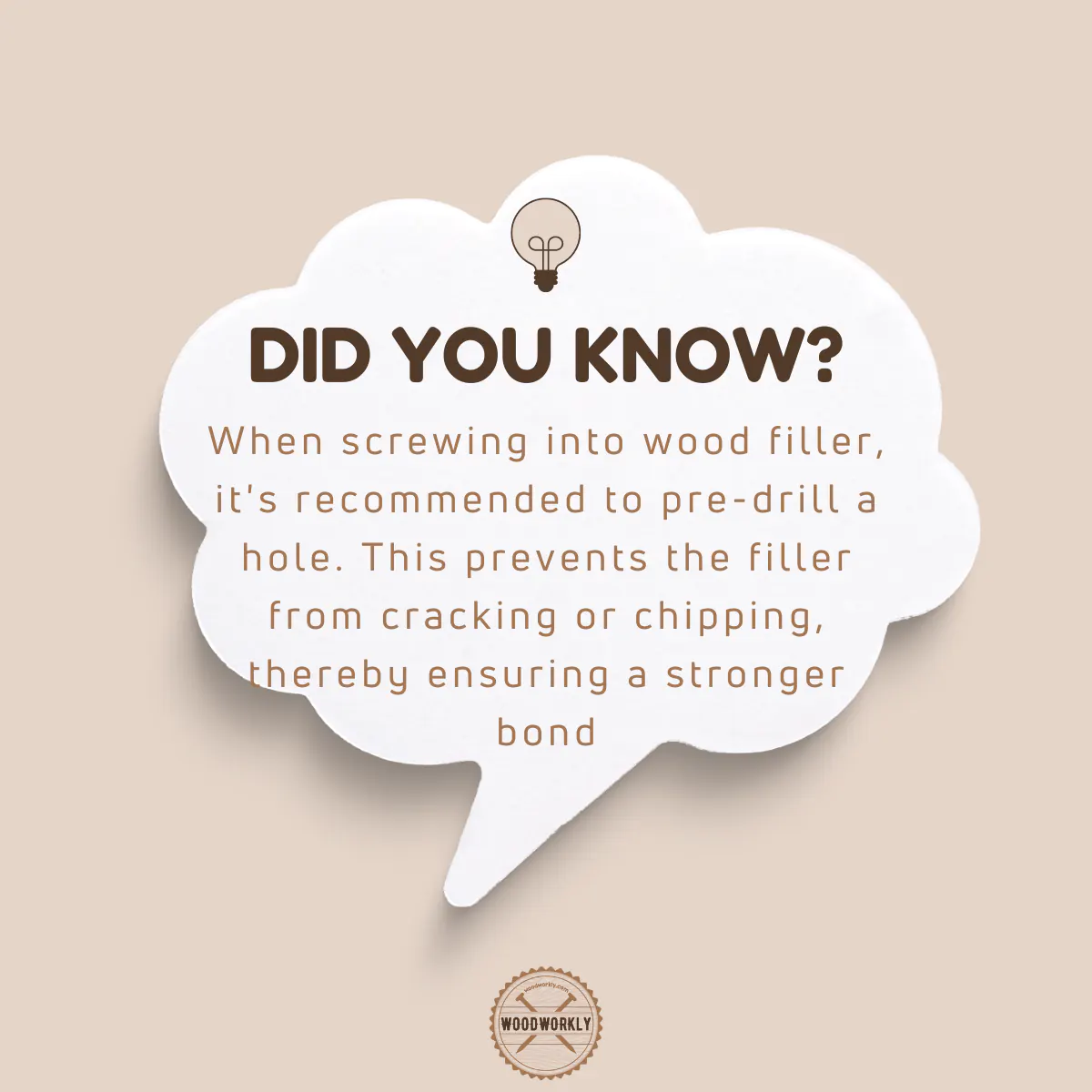
Enough chit chats! Let’s see how to fill a hole with wood filler to screw in again.
Supplies for Applying Wood Filler to Hold a Screw
- Two-part epoxy wood filler with hardener (16:1 ratio)
- Putty knife
- Scrapers
- Sandpapers
- Mixing bowl
Grab the above tools and materials and get ready to apply screwable wood filler.
How To Apply Wood Filler to Hold a Screw?
When you’re applying wood filler to hold screws or nails need to follow the right technique for best results.
Drilling too deep makes the wood filler get crack and damages the whole project.
Here’s the procedure you need to follow when applying wood filler to hold a screw,
- Surface preparation.
- Prepare the wood filler.
- Apply the wood filler.
- Allow wood filler to dry and cure.
- Finishing.
- Screwing into wood filler.
So, let’s discuss each of the above steps in detail to get promising results when applying wood filler to hold a screw.
1. Surface Preparation
Before the application of wood, filler removes loose paint, loose wood chunks, and stains around the wood area you wish to work.
Light sanding is also recommended to get a nice and smooth surface and remove rough edges and corners.
After the sanding is done, take a clean cloth or rag and remove sawdust and debris in the area.
This will make the surface ready to take the wood filler effectively.
2. Prepare the Wood Filler
Then open the wood filler, take the necessary amount, and place it in a mixing bowl.
Then apply the hardener on top of the wood filler that is kept in the mixing bowl 16:1 ratio.
That means only a little amount of hardener is enough to mix with a large amount of wood filler that was taken to the mixing bowl.
After that mix them until the white hardener disappears.
When you feel wood filler and hardener are mixed well, you have 15 minutes according to the instructions to apply this material to the wood surface.
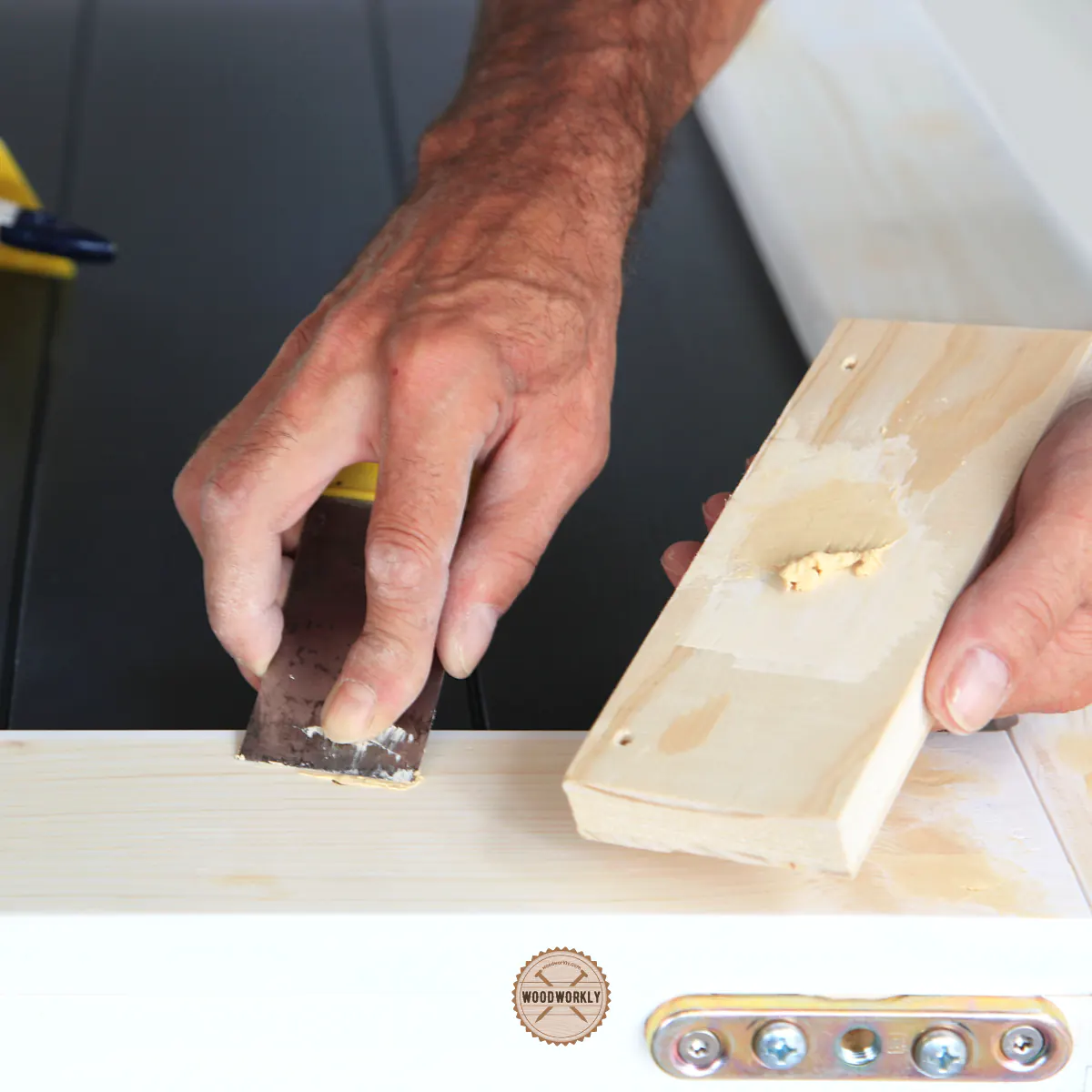
3. Apply the Wood Filler
Right after wood filler and hardener is mixed completely, take the putty knife, and start the application process to the area.
Press the wood filler into the cracked areas to fill the holes entirely.
Better to apply an excessive amount of wood filler to the holes because wood filler tends to shrink when they are drying.
So, little excess work as an allowance to fill up the entire surface.
Make sure to finish the application process within around 10 minutes because once it hit the 15-minute mark, the wood filler will start to dry and harden which will be so difficult to apply.
4. Allow Wood Filler to Dry and Cure
After the wood filler is applied correctly, let it dry and cure for 20 – 30 minutes to several hours.
If you live in a humid area, this can take even 3 – 4 hours. Patience is the key to getting the best results.
5. Light Sanding
Once the applied wood filler is dried and cured, lightly sand the filled area with 220 grit or 320 grit, or any other fine grit sandpaper.
Make sure not to sand with high force, since putty-based wood fillers are too soft and may break under excessive sanding.
If you sanded too much, better to start over and apply another layer of wood filler before heading into the next step.
5. Finishing
When the wood filler is completely dried and cured, you can apply any paint or stain to make it covered and match according to the other areas of the wood.
Make sure to apply a thin layer of paint or stain to avoid wood finishing mistakes.
This is helpful to make the area as fresh as new and hide the wood filler patches.
6. Screwing into Wood Filler
After finishing the wood filler application, drying, and finishing process wait for around 24 -48 hours to screw into wood filler.
Before screwing into wood filler make sure to take,
- Perfect size of drill bit size according to the wood type.
- Suitable drill
- Screws
Make sure to apply Two-part epoxy resin before screwing into wood filler as discussed above. Because no other wood filler can hold screws well without cracking than two-part epoxy wood filler.
Better to start with a small drill to test the wood filler and better to make a pilot hole before drilling to screw so easily.
If you accidentally make big screw holes, Follow this guide to fix screw holes that are too big!
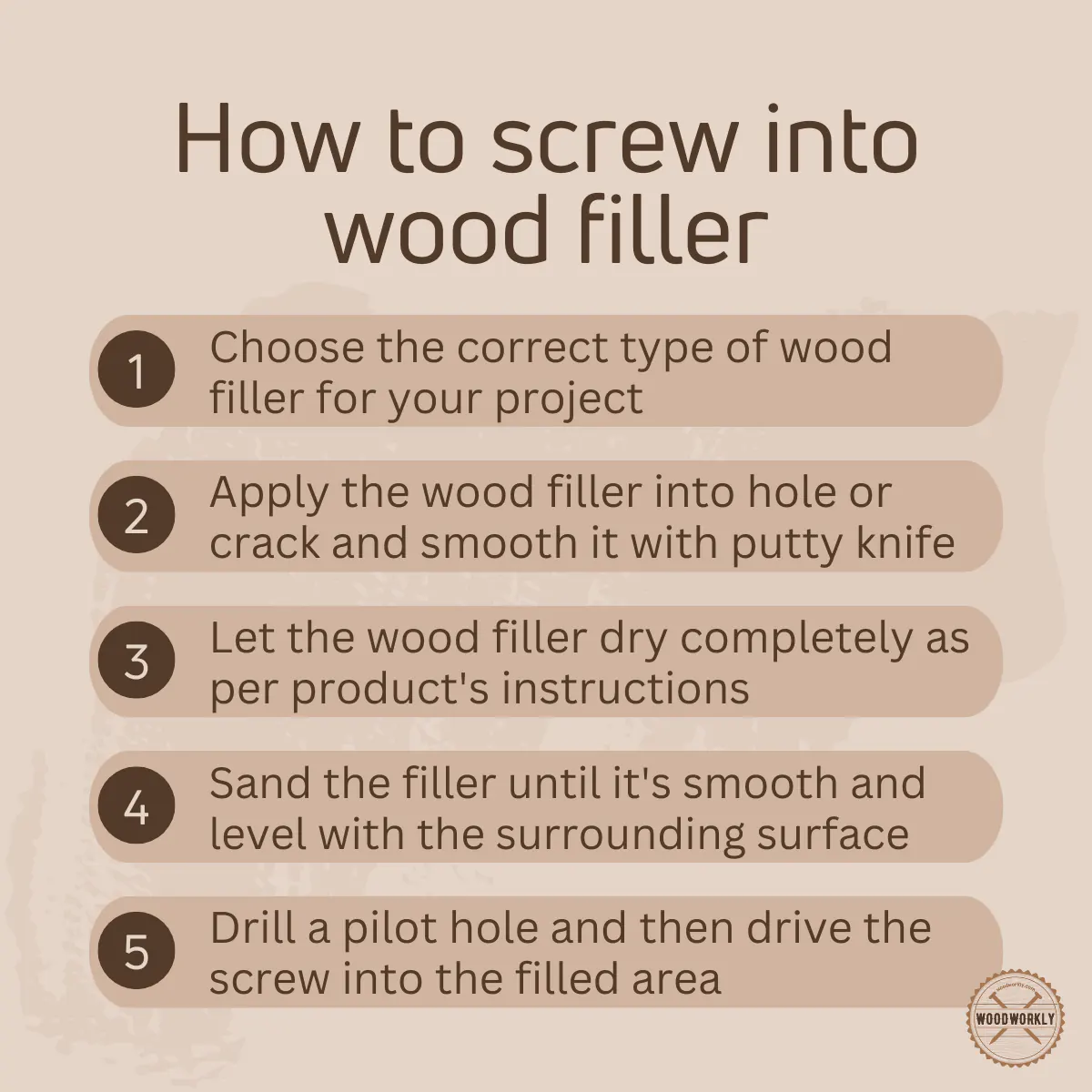
Issues With Screwing Into Wood Filler
Sometimes the unexpected happens and we might find ourselves in a position where we need to screw into wood filler.
While this can work in certain situations, it’s important to be aware of some potential issues that might arise.
Let’s explore these concerns in more detail.
Lack of Structural Strength
One of the primary issues with screwing into wood filler is the lack of structural strength.
Wood fillers are excellent for filling in gaps, covering blemishes, or evening out a wood surface, but they do not have the same strength as solid wood.
If you need a screw to hold a heavy load, support a joint, or withstand stress or movement, the wood filler might not hold up over time.
Consider, for instance, the hinges on a door.
If the screw holes have become worn out and you decide to fill them with wood filler, the filler might not hold the weight of the door, especially if it’s frequently used.
The screws could potentially come loose, causing the door to sag or fail.
Durability and Longevity Concerns
While certain types of wood fillers, such as epoxy-based or two-part fillers, are more durable than others, none can match the durability and longevity of real wood.
The filler may not hold up to wear and tear over time, and the screw might lose its grip, leading to instability.
For instance, if you’ve used wood filler on an outdoor piece of furniture and you’ve had to screw into the filler, the combination of weather conditions and frequent use might cause the filler to degrade faster, thus compromising the screw’s hold.
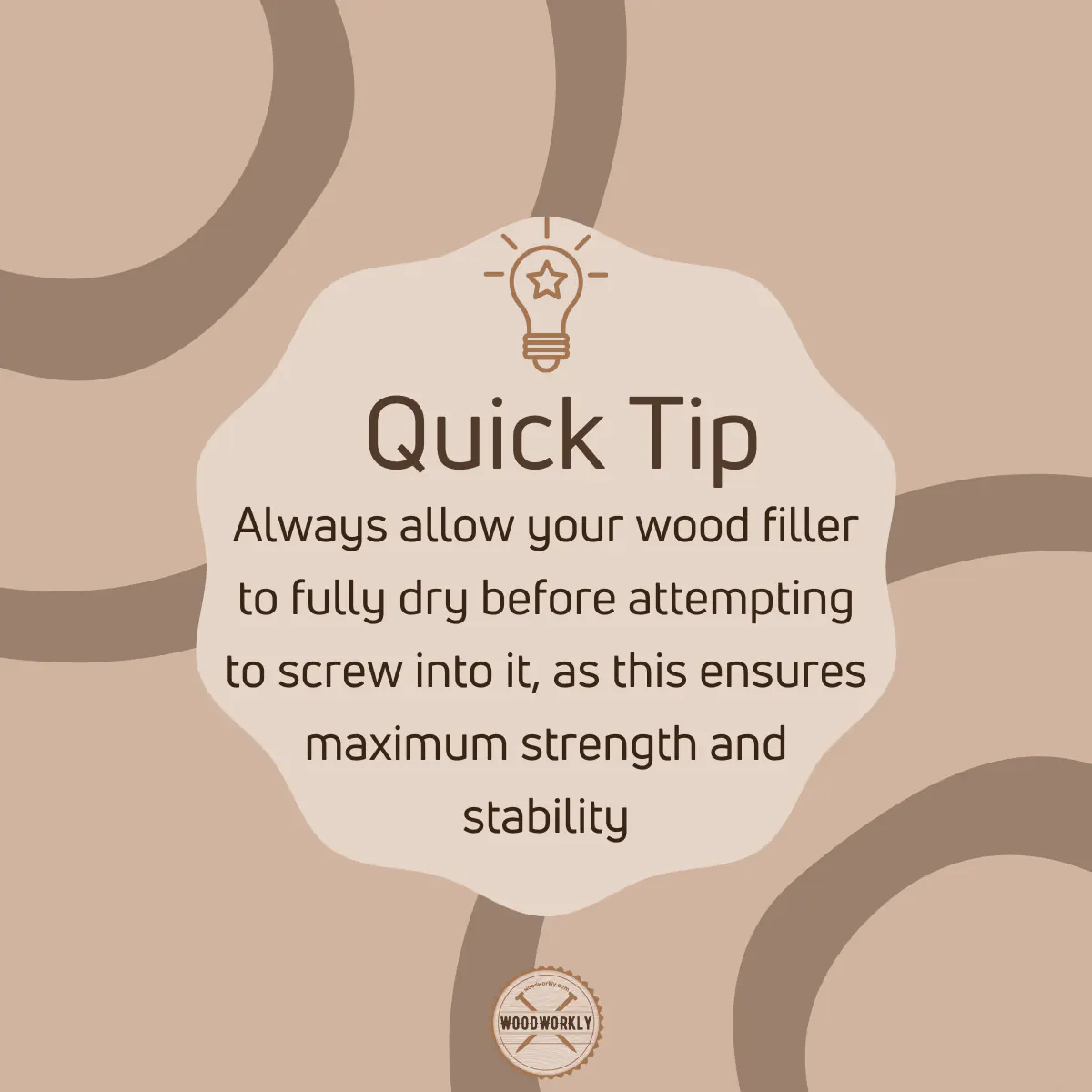
Cracking and Splitting
When you drive a screw into wood filler, there’s always the risk of the filler cracking or splitting, especially if you don’t drill a pilot hole first.
This is because the force exerted by the screw can put too much pressure on the filler, leading to damage.
Moreover, wood fillers might not handle the expansion and contraction due to temperature changes as well as solid wood does, leading to potential cracking over time.
In my own experience, I’ve learned that while wood filler can be a quick fix in certain situations, it’s not a solution for everything.
There have been times when I’ve attempted to screw into wood filler, only to find the filler cracking, or the screw not holding as firmly as I would like.
My biggest takeaway has been this: whenever possible, it’s better to use solid wood for structural or load-bearing applications.
When wood filler is necessary, ensure you’re using a high-quality, durable product, drill pilot holes to reduce stress on the filler, and understand that it’s more of a temporary solution rather than a permanent fix.
So, let’s see whether can you screw into wood fillers from different manufacturers.
Can You Screw into Ronseal Wood Filler?
Yes, Ronseal wood filler is a multipurpose wood filler that won’t crack or shrink easily.
Therefore, you can screw into Ronseal wood filler without any issue by following instructions.
Can You Screw into Dap Plastic Wood Filler?
Yes, Dap Plastic wood filler can be screwed. It provides strong anchoring to the screws without splitting.
Other than that DAP Plastic wood filler can cut, drill, sand, varnish, paint without any issue.
It is a multipurpose outstanding wood filler for any woodworking activity.
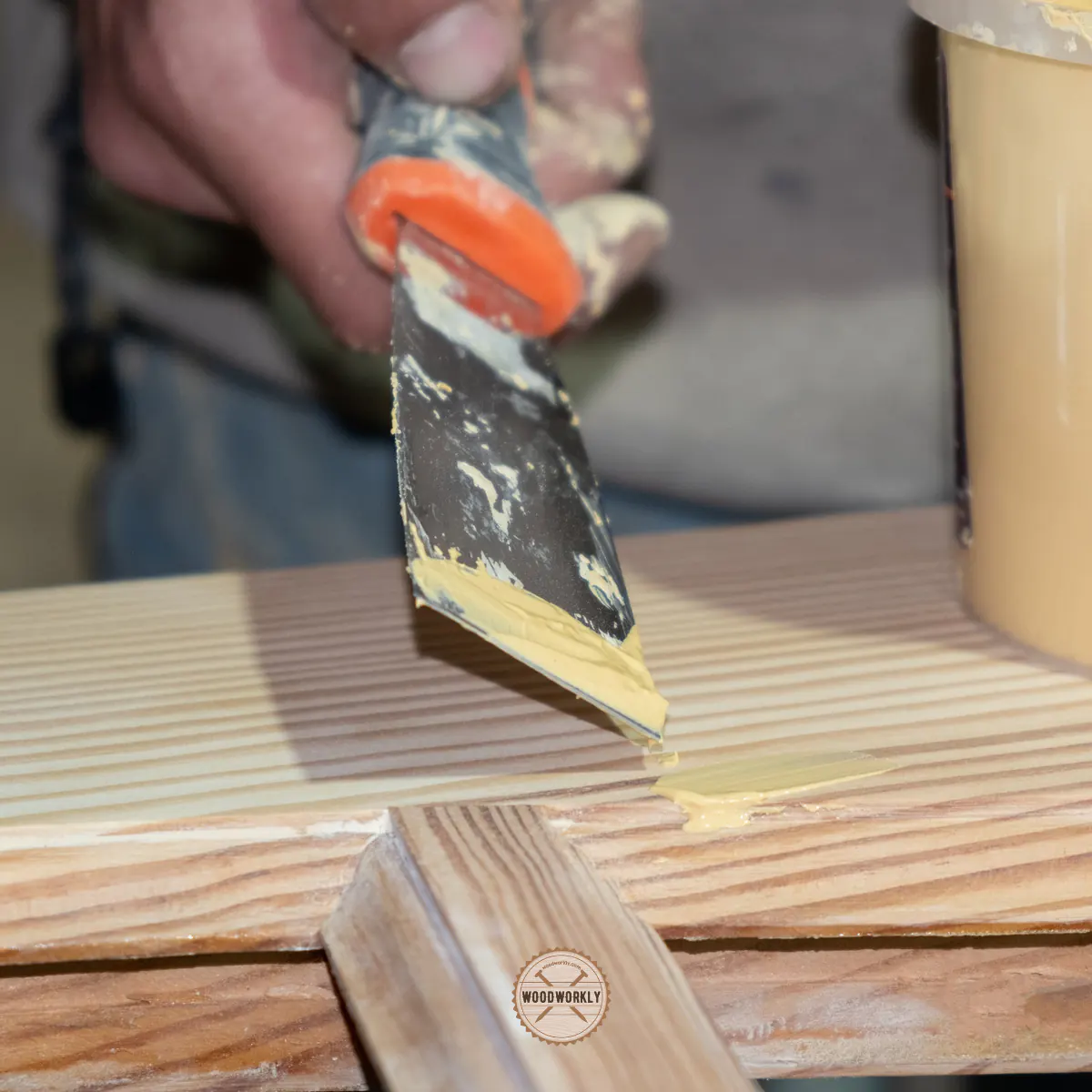
Now I’m going to share with you some tips and tricks that can be useful when screwing into wood filler.
I have learned the below tips by working on many different woodworking projects.
Tips for Screwing Into Wood Filler
Alright, woodworkers! Let’s dive into some handy tips and best practices to navigate the tricky waters of screwing into wood filler.
While we’ve already discussed the potential issues with this, there may be instances where you have no other choice.
So let’s make sure we do it right!
Choose the Right Filler
As I discussed earlier, all wood fillers are not created equal.
Some are much more capable of handling the stress of a screw being driven into them than others.
I’ve found that two-part epoxy wood fillers are usually the most durable.
They might be a little more time-consuming to prepare and use, but the trade-off in strength and durability can be worth it.
Drill a Pilot Hole
Drilling a pilot hole before screwing into the wood filler can make a huge difference in preventing the filler from cracking or splitting.
The pilot hole should be slightly smaller than the diameter of the screw you’re using.
This helps to reduce the stress on the wood filler when the screw is driven in, minimizing the chances of it cracking or splitting.
Don’t Over-Tighten the Screw
A common mistake I’ve seen (and admittedly done myself a few times) is over-tightening the screw when it’s being driven into wood filler.
While you might think that a tighter screw equates to a stronger hold, over-tightening can actually cause the filler to crack, or the screw to lose its grip.
So, remember – snug, but not over-tight.
Give Wood Filler Time to Dry and Cure
Patience is a virtue, especially in woodworking.
After you apply the wood filler, make sure to give it ample time to cure before attempting to screw into it.
The curing time can vary based on the type of filler, so always follow the manufacturer’s instructions. This helps the filler achieve maximum hardness and strength.
Reinforce When Possible
If you can reinforce the area where you’re using the wood filler, do it!
This could mean using a dowel or a plug in the hole along with the filler. This will help provide additional structural strength.
Know When to Replace Instead of Repair
Finally, it’s crucial to understand that while wood fillers can be incredibly useful for minor repairs and cosmetic fixes, they are not always the right solution for more serious structural issues.
If a piece of wood is significantly damaged, it may be better to replace it entirely rather than trying to repair it with wood filler.
From my own experience, the learning curve in woodworking is a continuous process.
I’ve had my share of mishaps and blunders, but every mistake was an opportunity to learn and improve.
Screwed up a piece by screwing into wood filler? No worries.
Take it as a lesson learned, and know that you’re becoming a more skilled and knowledgeable woodworker with each project you undertake!
Congrats folks! now you know everything you need to know about, can you screw into wood filler with all the tips and tricks.
Read to know the Best Wood Fillers for Screw Holes!
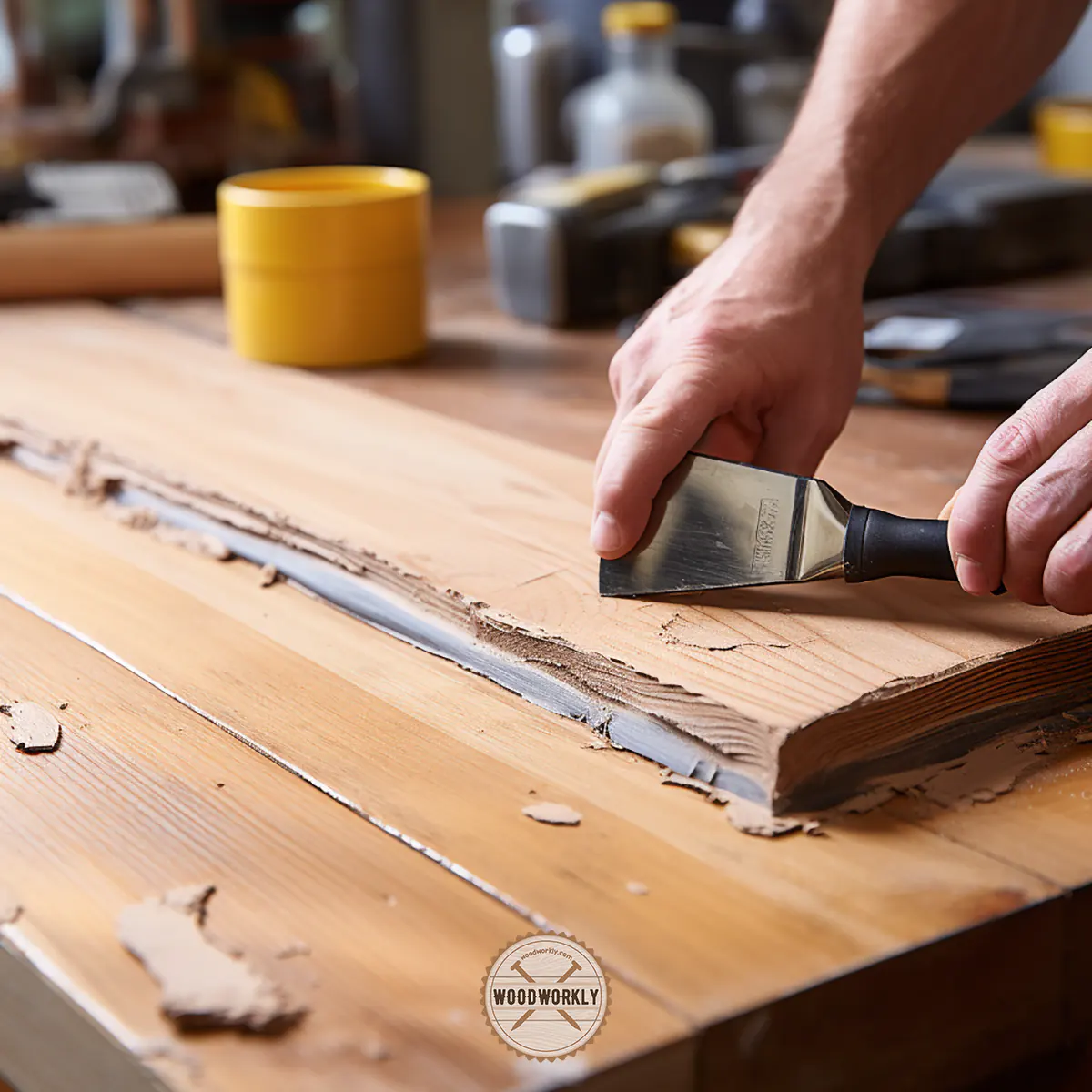
Let’s answer some frequently asked questions.
FAQs
Can I screw into any type of wood filler?
While you technically can screw into any type of wood filler, some types like epoxy-based fillers offer a better hold and durability compared to others.
What should I do to prevent the wood filler from cracking when I screw into it?
Drilling a pilot hole slightly smaller than the diameter of your screw can help prevent the filler from cracking.
Why does the screw keep loosening when screwed into wood filler?
This could be due to over-tightening the screw or the filler not being fully cured; remember to allow the filler enough time to dry and harden before screwing into it.
Is there a way to reinforce the wood filler to make it more robust?
Yes, you can reinforce the wood filler by using a dowel or a plug in the hole along with the filler to provide additional strength.
Is wood filler a good solution for significant structural repairs?
While wood fillers can fix minor damages and cosmetic issues, for substantial structural repairs, it’s often best to replace the damaged wood entirely.
Should I wait after applying wood filler before screwing into it?
Yes, allowing the wood filler to fully cure before screwing into it will help achieve maximum hardness and strength.
How can I ensure a strong hold when screwing into wood filler?
Choose the right type of filler, drill a pilot hole, avoid over-tightening the screw, and give the filler time to cure for a strong hold.
Can You Reuse Screw Holes in Wood?
Yes, you can reuse screw holes in wood by filling them with wood filler, dowels, or even toothpicks and wood glue, then allow them to dry before re-drilling the hole.
How Do You Fix a Stripped Screw Hole in Wood?
Fixing a stripped screw hole in wood can be done by filling the hole with wood filler or inserting a dowel with some wood glue, letting it dry, and then re-drilling the hole.
Can you screw into Bondo?
Yes, you can screw into Bondo. However, as it’s primarily used for filling and smoothing, it’s best to avoid any major structural or load-bearing applications.
Can you screw into wood glue?
Screwing directly into wood glue is not recommended. Wood glue is meant to bond wood pieces together, not to provide structural support for screws.
Wood putty vs wood filler for screw holes?
Wood filler, particularly epoxy-based, is a better choice for screw holes as it hardens and can provide some hold. Wood putty stays relatively soft and is used mainly for cosmetic repairs.
Can you screw into wood putty?
Yes, you can screw into wood putty but it’s not advisable as it doesn’t harden like wood filler, and thus won’t provide a solid grip for the screw.
Did I cover all you wanted to know about: Can You Screw into Wood Filler?
In this article I have deeply explored about can you screw into wood filler and how can you drill wood filler to hold the screws so well.
I have discussed, types of wood fillers that can take screw well without splitting and identified the drilling depth size for different wood types as well.
You can screw into wood filler, but it’s not always recommended because wood filler isn’t as strong as solid wood. If you have to, use a two-part epoxy filler, drill a pilot hole, and avoid over-tightening the screw. Also, ensure the filler has fully cured before you screw into it.
Most importantly, select the best wood fillers that can screw into and let it dry before the screwing process to get the best results.
The main purpose of wood filler is to fill up the holes and not to take drills or screws.
But you can screw multipurpose wood filler without splitting as an extra advantage. But make sure not to apply heavy load or stress to the area which can ruin the project.
Furthermore, I’ve answered some frequently asked questions as well.
Hope you have gained pretty good knowledge about whether can you screw into wood filler and surrounding topics.
So, let’s jump into your next woodworking project like repairing surfaces using wood filler, and learn something new. Have fun!